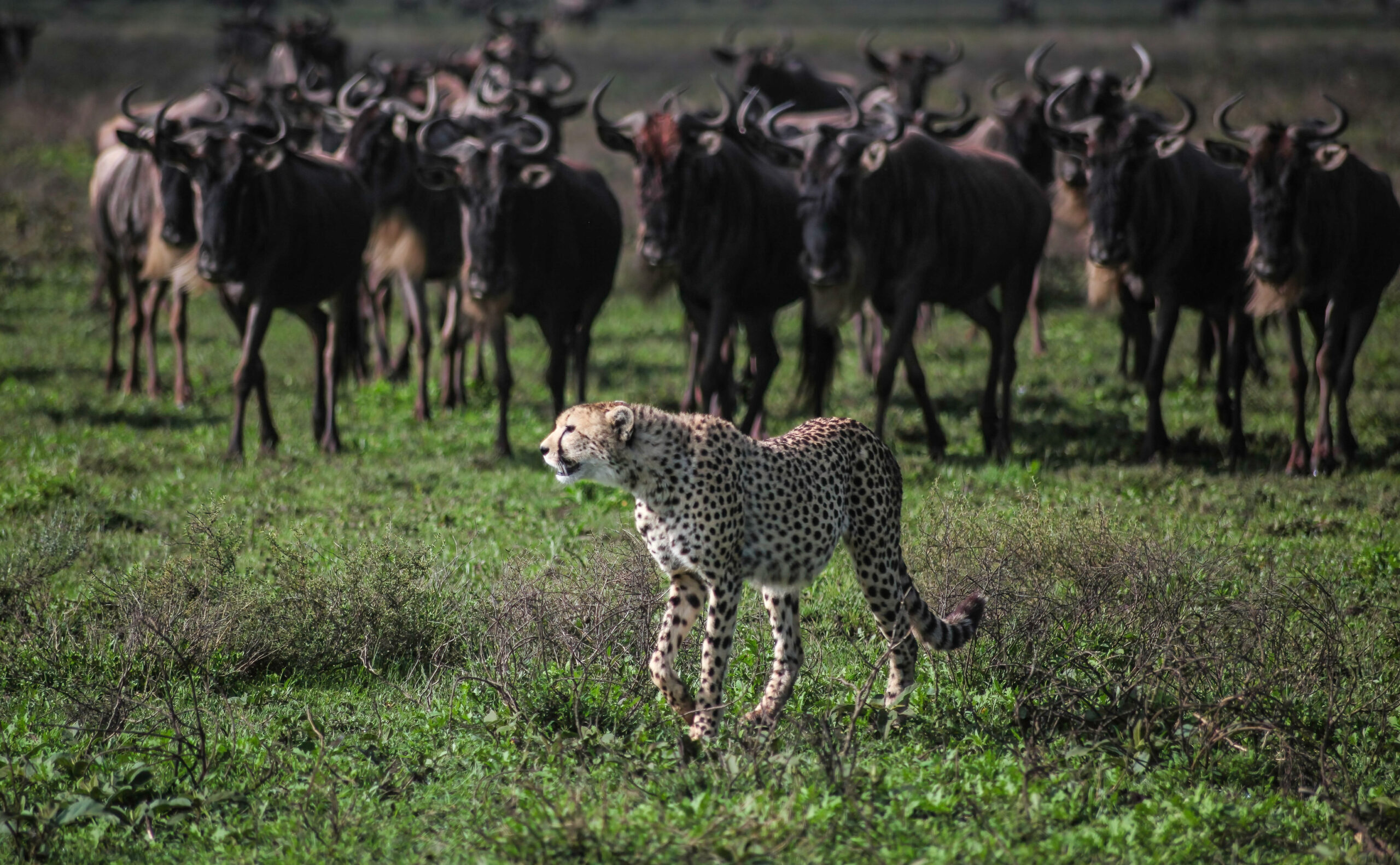Serengeti
A little bit about Serengeti
Home to the great migration.
Chances are that you have dreamt of Africa, and when you did, you probably dreamt about the Serengeti. Countless wildlife movies have been recorded in the Serengeti, and with good reason: this is the home of the Great Migration and may very well be one of the last true natural wonders on planet earth.
Serengeti National Park is a World Heritage Site teeming with wildlife: over 2 million ungulates, 4000 lions, 1000 leopard, 550 cheetahs and some 500 bird species inhabit an area close to 15,000 square kilometers in size. Join us on a safari and explore the endless Serengeti plains dotted with trees and kopjes from which majestic lions control their kingdom; gaze upon the Great Migration in awe or find an elusive leopard in a riverine forest. Or perhaps see everything from a bird’s-eye view and soar over the plains at sunrise during a hot air balloon safari. Accommodation options come in every price range – the sound of lions roaring at night is complimentary.
Serengeti National Park highlights
Serengeti National Park is nature. At its wildest. However, besides the Great Migration there is much more for you to explore and experience.
The Serengeti is the place for a picture perfect safari, a destination that fulfills your wildest dreams, time and time again. Why not explore some of the more remote corners of this vast national park? Or meet your hosts, the Maasai? Of course you can also take to the skies, and see the plains from above when when floating through the air on a hot air balloon safari.
Why Book With Us?
Price Includes
- Transportation in a 4×4 safari vehicle
- Professional, English speaking guide
- Transportation in a 4×4 safari vehicle
- Overnight accommodation
- All national park fees
- Mineral water & meals while on safari
- All government taxes
Price Excludes
- Visa and Travel insurance
- Guide Service Fee
- International or Local Flights
- Personal spending money for souvenirs etc.
- Optional activities
About Serengeti
Discover Serengeti With Us

Drive-in, fly-in or combo safari?
Many roads lead to Serengeti National Park. So which one should you choose? This really depends on your wishes, needs and further travel plans. If you’re looking for a fast and convenient way to travel, or just have a few days to spend in the area, a fly-in safari is the option for you. If you’re planning to visit some other sites as well or looking to save some money on transportation, a drive-in safari is the way to go. A popular option is to combine these two, starting with a drive-in safari from Arusha, with an overnight stay at the Ngorongoro Crater along the way. From the crater it’s just an three hour drive to the Serengeti National Park. After your Serengeti safari you can fly out from one of the airstrips – saving you at least eight hours of driving to Arusha. More information on transportation modes may be found on our how to travel to the Serengeti National Park page.
Most travellers pick the dry season (which takes place from late June to October) for a safari in the Serengeti National Park. Animals gather around rivers and waterholes to quench their thirst. The Great Migration is at its absolute prime and your chances of witnessing an iconic river crossing are at their best. Most lodges will remain open during the more tranquil ‘wet season’ when the rains turn the dry landscape into a lush, green oasis and the birthing season begins. Read more about Serengeti weather & climate on this page. Here are some pros and cons for the wet and dry season.
June to October - dry season
Pros:
- The thick bush thins out and wildlife is easier to spot.
- Animals will gather around the rivers and waterholes.
- Expect bright days and lots of sunshine with afternoon temperatures around 25°C / 77°F.
- Less chance of malaria, since there are fewer mosquitoes.
- Easier to spot the Great Migration (including these iconic river crossings, if lucky).
Cons:
- The park gets crowded, especially around the Seronera area.
- It gets relatively cold at night and early in the morning with minimum temperatures around 14°C / 57°F.
- Occasional cold fronts are possible, with temperatures close to freezing.
November to May - wet season
Pros:
- Late January to February is the time to see the calving in the Southern Serengeti – an excellent time to see predator action.
- A lush and green landscape.
- Fewer tourists and lower rates, especially in April and May.
- Birdwatching is at its best.
- From November to February, rains are mostly short afternoon storms and seldom interfere with your trip.
Cons:
- March to May is the peak of the wet season; It tends to rain most days, although seldom for the whole day. It is often cloudy.
- January to March can be crowded around the Seronera area.
Although popular image dictates that Africa is mostly a very hot place, Serengeti’s climate is actually very pleasant and moderate. It seldom gets uncomfortably hot, and temperatures drop during the night and early mornings. The minimum and maximum temperatures vary with the seasons, with the wet season being the warmest. The Seronera area rarely exceeds 37 °C on a hot afternoon in the rainy season, and hardly ever dips below 13 °C on a cold early morning in the dry season.
The average maximum daily temperature changes with elevation: from 15°C near the crater highlands to about 30°C near Lake Victoria. Because of its altitude, Serengeti National Park is a ‘cool island' in a much warmer region.
Rainfall periods in Serengeti
There are two rainy periods in Serengeti National Park. The short rains from November to December are the first to break the grip of the dry season. These rains are unpredictable and are unlikely to interfere with your safari. The long rains follow the short rains in the period from March to May, which are the highest rainfall months. It seldom rains for the entire day, but please remember that it rains on most days. As a result, the landscape turns green and as a result this season is often dubbed the ‘green season’. Sometimes the rains fuse into one extended period, particularly in the north. Or the short rains may fail entirely, especially in the southeast of the Serengeti.
Rainfall gradient
There is a rainfall gradient from the dry southeast plains (400 mm per year) to the much wetter northwest near the Kenyan border and the Masai Mara (up to 1,200 mm per year). The low rainfall on the Serengeti plains is caused by the rain shadow of the Ngorongoro Crater Area and the Meru-Kilimanjaro mountain range. Prevailing south-easterly winds carrying moisture off the Indian Ocean are forced to rise over these highlands. As the air cools the moisture condenses and the water in the air rains out. However, shifting winds can carry moisture back inland from Lake Victoria, counteracting this effect, and inducing this rainfall gradient.
Why do wildebeest migrate?
The 800 kilometer trek of the immense wildebeest herd is the largest mammal migration on earth. The timing of the migration coincides with greening of nutritious grasses on the short-grass plains during the wet season. These areas are safer because predators can be easily spotted making it an ideal place for calving. However, the plains dry and the wildebeest are forced to move in search of greener pastures in the western corridor. The northern extension of the ecosystem has the highest rainfall, but the grasses are least nutritious. This is the dry season retreat for the wildebeest, at least until the south becomes green again. The result is a clockwise movement from the south, west, north, and back to the south.
The Great Migration in short
A better representation of the circle of life probably cannot be found anywhere else in the world. The journey starts in Southern Serengeti when wildebeest calves are being born. Predators like lions and hyenas are constantly hunting for babies, and thousands and thousands of calves are born within a couple weeks of each other – a feast for the eyes of true wildlife enthusiasts.
When the drought comes in May, the herd moves north, towards the Masai Mara in Kenya, chomping down the high green grass, quickly followed by the gazelles and zebras. The migration is not without risk: crossing rivers means facing about 3,000 crocodiles, patiently waiting for a kill. Not to mention the famous Serengeti lion population: by far the largest in Africa. Despite the abundance of hoofed meat in this area, life is not easy for these big cats in this unforgiving landscape. But seeing a group of lions collaborating to hunt down a wildebeest is an unforgettable sight.
Then, with the beginning of the short rains in late October, the migration makes its way back into the Serengeti. By December, the herds trek past Seronera - a small settlement in central Serengeti where the official Serengeti Visitors’ Centre is located - to return to their calving grounds again, and the circle is complete.




